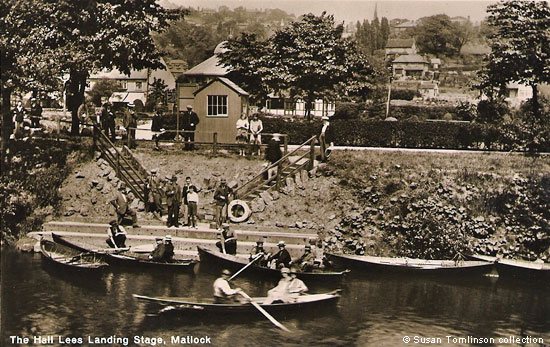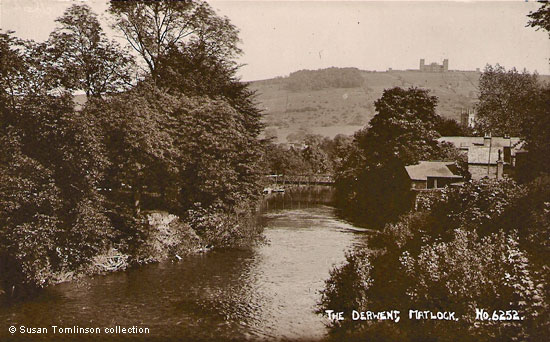|
Images Index> Matlock, 20th and 21stC Images> This page |
| Matlock: Hall Lees Park, Boating on the Derwent, 1930s |
| Matlock : Twentieth Century Photographs, Postcards, Engravings & Etchings |
|
|||
|
In 1909 one of the Council's ideas for the development of the Hall Leys was "a boat landing for the resuscitation of boating on the Derwent"[3]. Boating was banned for some time after a double fatality near Pic Tor promenade and the boats then in use were scrapped. However, in 1929 the Council decided to re-introduce boating as a leisure activity on the River Derwent. A Council sub-committee was given the sum of £50 to spend on the preliminary arrangements[4]. By August they were discussing how to give Matlock one of the finest boating stretches in the Midlands[5] and even contemplated making the river Derwent about three feet deeper. The alteration would increase the navigable stretch of water to about two miles, from Artists' Corner to Darley Meadows. The Council visited Artists' Corner and considered the proposal for the erection of a weir which would raise the level of the river. They also contacted the manager of the colour works about raising their weir by three feet[6]. The photograph above would have been taken from the river bridge connecting the Hall Leys with Old English Road as there was a landing stage on the Hall Leys side of the riverbank where the boats could be hired. The edge of it can just be seen in the bottom right corner, where the bows of two of the rowing boats are moored.
The small hut on the Broad Walk has a sign next to it, which would have shown the tariffs. Behind the hut you can see the bandstand and the pavilion, and the shops next to the cinema on Causeway Lane.
Boats could still be hired in 1942 when there was an unfortunate fatality involving a young Council employee who was taken ill and drowned whilst his friend had gone for help[7].
|
|||
|
1. "Matlock, River Derwent & Boat Station". Photochrom Co Ltd, Royal Tunbridge Wells, No. 71261. Not posted, but two others franked 1932 and 1936. Postcard in the collection of, provided by and © Ann Andrews 2. "The Hall Leys Landing Stage, Matlock". No publisher and not posted. Postcard in the collection of, provided by and © Susan Tomlinson. 3. "Riber Castle from River Derwent, Matlock". J Salmon Ltd, Sevenoaks, no. 1526. Not posted. Printed bottom left, but not shown, is "From, With Greetings and Best Wishes". Postcard in the collection of, provided by and © Susan Tomlinson. 4. "The Derwent, Matlock". R Sneath Paradise Street Sheffield. No.6252. Postcard in the collection of, provided by and © Susan Tomlinson. Researched, written by and © Ann Andrews. Intended for personal use only. |
|||
|
[1] "Derbyshire Times and Chesterfield
Herald", various reports 1902 and 1903. After some negotiation,
Mr. Walton was paid £35 for his boats, boathouse, etc.;
it included five boats, two canoes, four pairs of sculls and
three paddles. Presumably the Mr. Walton was of the family at
the Wheatsheaf near Matlock Parish Church. There's a picture
of Walton's boathouse: Matlock Dale: High Tor and Abram's Heights, 1925 |








